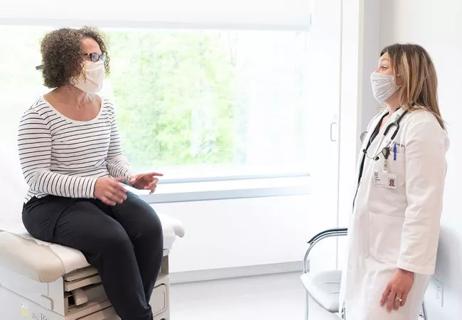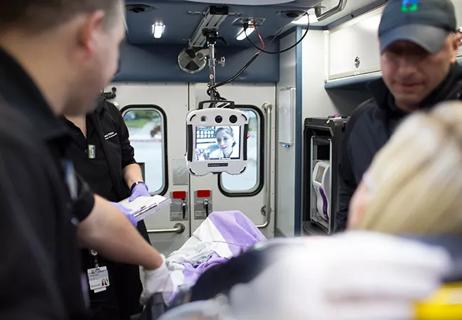New analysis details the disparities and points to opportunities for improvement

Women are underrepresented among physician authors of clinical practice guidelines from the American Academy of Neurology (AAN), concludes a cross-sectional analysis from Cleveland Clinic researchers published in the AAN journal Neurology.
Cleveland Clinic is a non-profit academic medical center. Advertising on our site helps support our mission. We do not endorse non-Cleveland Clinic products or services. Policy
“This finding, while not unexpected, indicates several missed opportunities,” says the study’s first author, Lindsay Ross, MD, a neurologist with Cleveland Clinic’s Mellen Center for Multiple Sclerosis Treatment and Research. “In addition to lost opportunities for professional development among women neurologists, underrepresentation of women in guideline development means that neurology as a specialty is not realizing potential improvements in care that could be gained from greater inclusion of women authors’ perspectives and expertise.”
The study was prompted by a 2018 analysis of clinical practice guideline authorship across more than two dozen medical and surgical specialties (Lancet. 2018;392:1626-1628) that found fewer women than men physician authors in all specialties, including neurology. “We decided to heed the call of that study’s researchers to further investigate authorship of guidelines published by societies in individual medical specialties,’” explains Dr. Ross.
She and colleagues from Cleveland Clinic’s Neurological Institute identified all clinical practice guidelines issued by the AAN from 2015 through 2020. Author gender and degrees were ascertained from the publication and/or online searches, with gender determined by pronouns or photographs. Authors’ gender representation was then compared with Association of American Medical Colleges (AAMC) data on academic neurologists.
According to the AAMC data, women’s benchmark representation among academic neurologists was as follows throughout the study period:
Across the six-year study period, 68 unique AAN clinical practice guidelines were published by a total of 709 physician authors, who broke down by gender as follows:
Statistical analysis showed that women’s 32% share of guideline authorship slots was significantly lower than their AAMC benchmark representation among the overall neurology specialty in 2018 and 2020 (P < 0.01 for both years).
Moreover, women represented 18% of physician first authors of practice guidelines, which was significantly lower than their benchmark levels in the specialty in 2015, 2018 and 2020 (P < 0.01 for all). In contrast, 32% of physician senior authors of guidelines were women, which was not statistically different from women’s overall representation in the specialty.
Further analysis showed that gender representation among authors varied by the gender of guidelines’ first author. When the first author was a man physician versus a woman physician, the proportion of other physician authors who were women was significantly lower (31% vs. 42%; P = 0.02). Only when women physicians served as first authors did women’s representation among the overall authorship team meet or exceed the specialty benchmark.
Although small sample sizes limited analysis by neurology subspecialty, four subspecialties produced more than 10 practice guidelines during the study period. Among these, child neurology had the highest share of women among overall physician authors (48%) and physician first authors (45%); neuromuscular disorders had the highest share among physician senior authors (45%); and stroke/vascular neurology had the lowest share among overall (16%), first (15%) and senior (8%) physician authors.
“Representation of women physicians was disproportionately low in all authorship roles — and significantly so for first authors and authors overall,” says Dr. Ross. “In view of demonstrated differences in practice habits and sometimes even in outcomes when care is delivered by men versus women physicians, this gender disparity may carry clinical implications for patients.”
Underrepresentation in guideline development also means that women neurologists miss opportunities for high-impact publications, national reputation enhancement and connections with other leaders in the specialty. “This tends to further perpetuate career and promotional gender gaps,” Dr. Ross adds.
The study authors write that their findings are “critically important” for AAN leadership to consider in light of the AAN’s formation of a Gender Disparity Task Force in 2016 to establish recommendations and take on gender inequities at a systemic, organizational level.
They add that beyond new actions by the AAN to promote gender diversity in guideline development, the federal government and other organizations that advise on practice guideline development have an opportunity to “enhance their recommendations regarding the diversity of author teams.”
The authors suggest that that existing tools used to inform guideline development, such as the AGREE II instrument, might be revised to account for author diversity and inclusiveness. They also see further opportunity in their finding that guideline teams with women physicians as first authors were the only ones where women physicians’ representation matched that of the specialty overall. “Providing additional opportunities for gender concordant leadership for women may be a strategy to improve gender disparities,” the authors conclude.

Analysis characterizes geography’s sizable role in urban/rural care divides

In survey, both female and male respondents reporting ongoing concerns

Group advocates for stroke systems of care supported by telestroke and proper reimbursement

Dr. Gregory Nemunaitis looks to build on his history of integrating education, research and patient care

Mission centers on screening, prevention for at-risk women in their 30s to 60s

One-year results from national database confirm enduring benefits

Q&A with Dr. Andrew Russman, Medical Director of our Comprehensive Stroke Center

From B-PROUD to EXTEND-IA TNK to a novel TMS delivery method